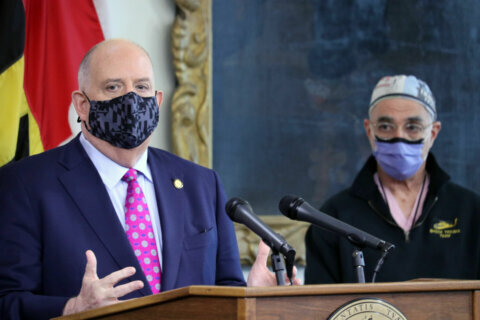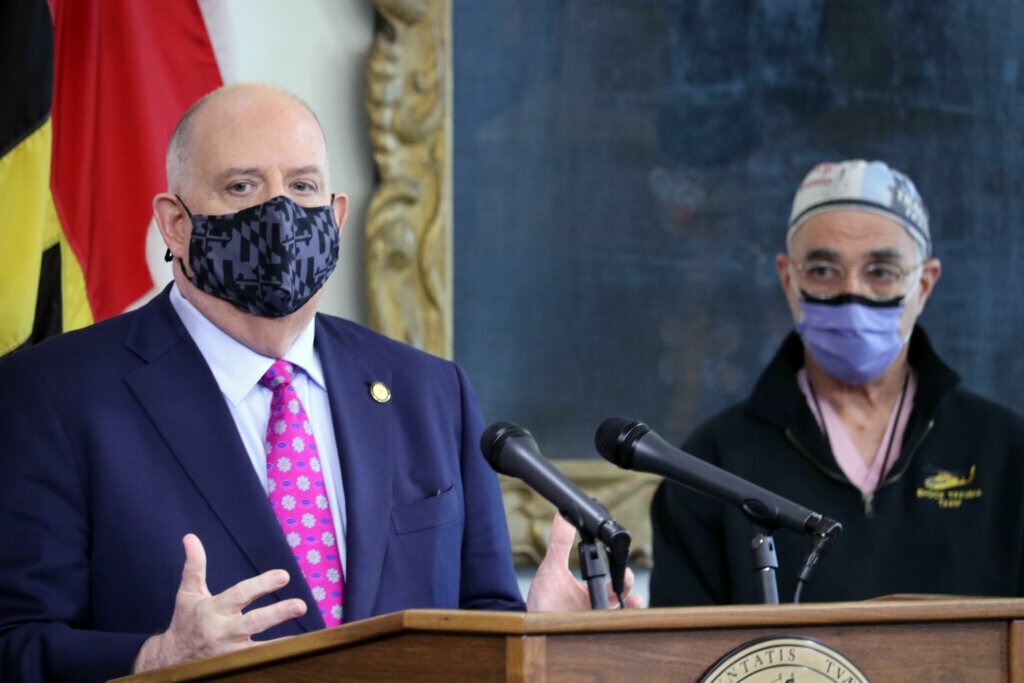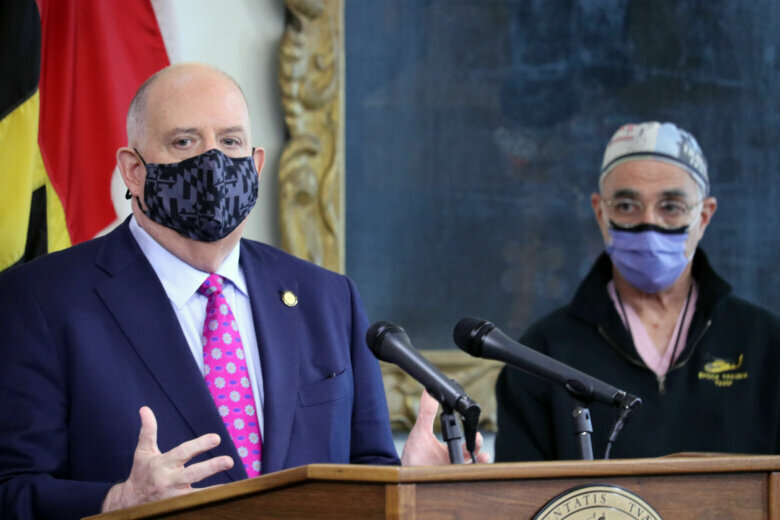

Maryland Gov. Larry Hogan, pointing to a “staggering, spiking” surge of coronavirus cases, announced Tuesday several new restrictions to slow the spread of the virus, including a 10 p.m. curfew for all bars and restaurants across the state and tightened capacity limits at retail outlets, religious facilities, barbershops and salons.
The new capacity limits at businesses will be capped at 50%, the governor said.
In addition, Hogan announced an emergency order from the Maryland Department of Health suspending most visitation at hospitals and nursing homes to protect vulnerable populations.
The “hospital surge” plan from the health department would also allow Maryland hospitals, which are nearing full capacity, to transfer patients to other facilities to alleviate overcrowding and ensure they can receive appropriate care.
“Every corner of our state” is now seeing widespread community transmission, Hogan said, before describing in blunt terms the seriousness of the latest surge in cases.
“It’s not fake news. It’s not going to magically disappear just because we’re all tired of it,” Hogan said, adding, “We are in a war right now — and the virus is winning. Now, more than ever, I’m pleading with the people of our state to stand together, a while longer, to help us battle this surging virus.”
The 10 p.m. curfew at restaurants and bars goes into effect Friday.
Hogan pointed to the state’s contact tracing data, which “shows a large uptick in new cases among Marylanders who have recently been exposed in bars and restaurants.”
In particular, compliance with public health measures, such as mask wearing and staying 6 feet away from others, “drops dramatically” later in the evening, Hogan said.
In addition to bars and restaurants, the order applies to any facility or venue where food and alcohol is served, including nightclubs and social clubs.
Takeout and delivery can continue after 10 p.m., but dine-in operations have to close between 10 p.m. and 6 a.m.
Hogan also called on local authorities to enforce existing rules limiting crowding at bars.
Meanwhile, the re-tightened capacity limits are in line with previous statewide restrictions, which were initially eased in early September.
The 50% limit applies to retail outlets; religious facilities; personal services providers, such as beauty salons and barbershops; bingo halls; bowling alleys; pool halls; roller and ice-skating rinks; and fitness centers.
In addition, fans will no longer be allowed at college or professional sports stadiums or racetracks.
- Sign up for WTOP alerts
- Latest coronavirus test results in DC, Maryland and Virginia
- Fairfax County schools delay in-person instruction for some students
- Howard County limits gatherings, schools to pare back in-person learning
- Fairfax County schools delay in-person instruction for some students
- Pandemic politics leave DC in gridlock as virus surges
Looking for more information? D.C., Maryland and Virginia are each releasing more data every day. Visit their official sites here: Virginia | Maryland | D.C.
‘Staggering, spiking numbers’
Tuesday’s announcement marked the third news conference by Hogan in the past week.
Last week, Hogan announced tighter statewide capacity restrictions on bars, restaurants and indoor gatherings — although most of the Maryland counties in the D.C. area have implemented more stringent restrictions.
The flurry of new rules come amid a surge of new COVID-19 cases cross the D.C. region.
In just the last few days, Maryland has twice reported more than 2,000 cases a day. Overall, Maryland has reported at least 1,000 new cases for 13 days straight.
The number of new cases per 100,000 is 29 — a 46% increase over the past week — which puts Maryland “in the red zone,” Hogan said. The test positivity rate — the number of coronavirus tests coming back positive — is now 6.85%, which is well above a 5% bench mark.
All told, 20 of 24 jurisdictions — including the more rural parts of the state that were spared in earlier waves of the virus — are above the 5% threshold in test positivity.
“This virus has been with us for so long that too many of us have become numb to staggering spiking numbers that are being announced every day,” Hogan said.
Growing concern about hospital capacity
There is also growing concern about hospital capacity amid the spike in cases. In Maryland, the number of people hospitalized with coronavirus has doubled over the course of the month — from 523 on Nov. 1 to 1,046 hospitalized patients on Nov. 17.
Currently, 85% of the state’s 6,600 staffed hospital beds are filled. For the first time since June, there are more than 1,000 Marylanders hospitalized with the virus and 255 people in intensive care units, according to the governor.
The plans announced Tuesday include a “hospital surge” effort, designed to prevent hospitals from becoming overburdened with critically ill patients. The plan allows hospitals that are full or nearing capacity to transfer patients to other hospitals that can handle them.
“Our highest priority right now is preserving capacity at our hospitals so that our doctors and nurses can do their jobs and make sure people get the right critical, lifesaving treatment,” Hogan said.
The state health department also issued an order Tuesday urging hospitals to avoid admitting patients for elective procedures that are not urgent or lifesaving.
Maryland has reported a total of 4,186 coronavirus-related deaths.
“We’ve lost more Marylanders to COVID-19 than we lose each year to car accidents, gun violence and the flu combined,” Hogan said.
The governor urged Marylanders to continue wearing masks and to get COVID-19 tests if they planned to travel for the upcoming Thanksgiving holiday.
Since announcing last week that he was canceling the large traditional Thanksgiving dinner he had planned, he said has heard from other Marylanders who were calling off their plans as well.
Hogan also told reporters about half the people contacted by state contact tracing teams refuse to participate with disease investigators, who track outbreaks and recommend quarantine and isolation measures.
“More important than any public health order is our willingness to take personal responsibility for our own actions, and to make the necessary sacrifices to limit our interactions, even sometimes with our own family members in order to protect ourselves, and one another, especially the most vulnerable,” Hogan said.









